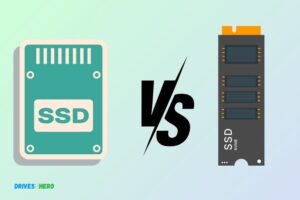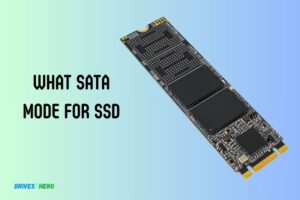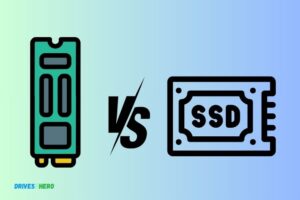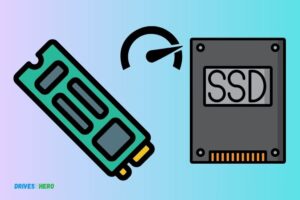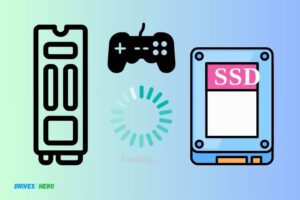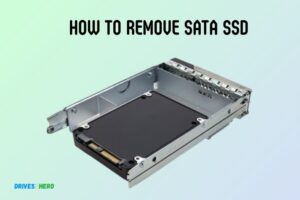Sata Ssd Vs 7200Rpm Hdd: Which One Better!
When comparing a SATA SSD (Solid State Drive) to a 7200RPM HDD (Hard Disk Drive), the SSD tyically surpasses the HDD in terms of speed, reliability, and durability.
Both devices serve the same purpose of data storage but the difference lies in the technology used to store and access this data. A SATA SSD is a type of storage device that uses flash-based memory to store data.
It is significantly faster than a 7200RPM HDD because it doesn’t have to mechanically seek out the data on a spinning platter.
Instead, it uses integrated circuits to read and write data, which is a much quicker and more reliable process.
On the other hand, HDDs are based on older technology that reads data from a spinning disk which can make them slower and less reliable over time.
When comparing SATA SSDs to 7200 RPM HDDs, it becomes evident that SSDs offer a significant performance boost and numerous advantages.
SATA SSDs, with their flash memory technology, provide lightning-fast data access speeds and almost instantaneous application loading times.
This results in a smoother and more responsive computing experience, making tasks such as booting up the operating system, launching software, and transferring files considerably quicker.
While 7200 RPM HDDs are more affordable and offer larger storage capacities, they struggle to match the speed and efficiency of SSDs.
As technology advances and SSD prices continue to drop, the choice between the two becomes increasingly clear for those seeking improved performance and responsiveness in their computing endeavors.
10 Features Of Sata SSD Vs 7200rpm HDD
| Feature | SATA SSD | 7200RPM HDD |
|---|---|---|
| Speed | High | Medium |
| Price | More expensive | Cheaper |
| Capacity | Up to 4TB | Up to 16TB |
| Power Consumption | Low | High |
| Noise Level | Silent | Noticeable |
| Durability | High | Medium to High |
| Boot Time | Faster | Slower |
| Failure Rate | Lower | Higher |
| Data Transfer Rate | Up to 600 MB/s | Up to 160 MB/s |
| Weight | Lighter | Heavier |
Key Takeaway
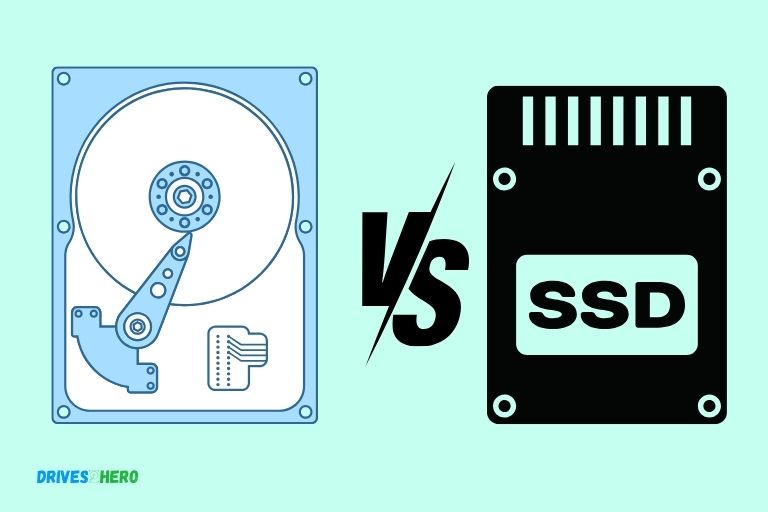
Five Facts About SATA SSD Vs 7200rpm HDD
What Is Sata Ssd?
SATA SSDs offer faster performance and improved reliability compared to 7200RPM HDDs. With their higher data transfer rates and lower latency, SATA SSDs provide a significant boost in overall system responsiveness and load times.
SATA SSD, or Serial Advanced Technology Attachment Solid State Drive, is a type of storage device that combines the benefits of both SSDs and traditional hard disk drives (HDDs).
With its lightning-fast speed and enhanced durability, SATA SSD has become a popular choice for individuals and businesses alike.
Definition And Explanation Of Sata Ssd:
- SATA SSD is a type of solid-state drive that utilizes flash memory technology to store and retrieve data.
- Unlike traditional HDDs, SATA SSDs have no moving parts, which not only makes them less prone to mechanical failure but also allows for faster data access.
- SATA SSDs connect to the computer’s motherboard through a Serial ATA interface, enabling quick and efficient data transfer.
Advantages And Benefits Of Using A Sata Ssd:
- Speed: SATA SSDs offer significantly faster read and write speeds compared to traditional HDDs. This means that applications load faster, files transfer quicker, and the overall system performance is enhanced.
- Reliability: With no moving parts, SATA SSDs are more durable and less susceptible to physical damage. They can withstand shocks, vibrations, and extreme temperatures better than HDDs.
- Silent operation: Since SATA SSDs don’t rely on spinning disks, they operate silently, eliminating the noise commonly associated with HDDs.
- Energy-efficient: SATA SSDs consume less power than HDDs, leading to lower electricity bills and longer battery life for laptops and other portable devices.
- Compact form factor: SATA SSDs are available in smaller sizes, making them suitable for space-constrained devices like ultrabooks and tablets.
- Compatibility: SATA SSDs use the same form factor as traditional 2.5-inch HDDs, allowing for easy installation and replacement in existing systems.
- Enhanced multitasking: The fast data access speeds of SATA SSDs enable seamless multitasking, allowing users to smoothly run multiple applications simultaneously.
- Reduced boot times: SATA SSDs significantly reduce boot times, enabling users to start their computers and launch applications in seconds.
Boosting Performance With Sata Ssd:
- Faster loading times: With their speed advantage, SATA SSDs drastically reduce loading times for programs, games, and large files, resulting in a more efficient and enjoyable user experience.
- Improved productivity: The quick data access provided by SATA SSDs enables users to work more efficiently by reducing lag time and waiting periods during file operations.
- Enhanced gaming experience: SATA SSDs can significantly improve gaming performance by reducing load times and minimizing input lag, resulting in smoother gameplay and a competitive edge.
- Increased reliability for businesses: SATA SSDs’ robustness and durability make them a reliable storage solution for businesses, ensuring uninterrupted operations and protecting critical data.
- Quicker data backup and recovery: With faster read and write speeds, SATA SSDs enable quicker data backup and recovery, allowing for improved data protection and reduced downtime in case of system failures.
Choosing a SATA SSD over a traditional 7200RPM HDD can provide a significant performance boost, better reliability, and improved user experience.
Whether for personal or business use, the advantages and benefits of SATA SSDs make them a worthy investment in modern-day storage technology.
What Is 7200 Rpm Hdd?
The 7200 RPM HDD is a traditional hard disk drive that offers faster data transfer speeds compared to lower RPM drives, making it a suitable choice for those who require a high level of data access and storage.
When compared to the SATA SSD, the 7200 RPM HDD is more affordable but lacks the overall speed and durability of the SSD.
Definition And Explanation Of 7200 Rpm Hdd:
A 7200 RPM HDD, or Hard Disk Drive, refers to a type of storage device commonly used in computers and other electronic devices.
The 7200 RPM indicates the rotation speed of the drive, where RPM stands for Revolutions Per Minute.
This means that the disk inside the HDD spins at a rate of 7200 revolutions per minute. This rotation speed plays a significant role in determining the performance and speed of the drive.
Advantages And Benefits Of Using A 7200 Rpm Hdd:
- Faster data access: The higher rotation speed of a 7200 RPM HDD allows for quicker read and write operations. This results in faster data access and retrieval, making it suitable for tasks that require efficient performance.
- Increased storage capacity: 7200 RPM HDDs typically offer larger storage capacities compared to their solid-state drive (SSD) counterparts. This makes them ideal for storing large files, such as videos, photos, and games.
- Cost-effective option: 7200 RPM HDDs are generally more affordable than SSDs, especially when considering higher capacity drives. This makes them a cost-effective choice for individuals looking for ample storage without breaking the bank.
- Compatibility with older systems: Unlike newer SSDs, 7200 RPM HDDs are compatible with older systems, offering backward compatibility. This allows users to easily upgrade their existing systems without worrying about compatibility issues.
- Reliability and durability: HDDs, including 7200 RPM models, are known for their robustness and durability. They are less susceptible to physical shocks and damages, making them a reliable storage solution, particularly in environments that require ruggedness.
- Suitable for multitasking: The high rotation speed of 7200 RPM HDDs enables them to handle multiple tasks simultaneously. This makes them suitable for multitasking environments, such as video editing, gaming, and running multiple applications simultaneously.
Cost-Effective Storage With 7200 Rpm Hdd:
- Lower cost per gigabyte: When compared to SSDs, 7200 RPM HDDs offer a lower cost per gigabyte of storage. This makes them an attractive option for individuals or businesses that require large amounts of storage without exceeding their budget.
- Value for money: With their affordable price and above-average performance, 7200 RPM HDDs provide excellent value for money. They offer a balance between performance and storage capacity, making them a popular choice for both budget-conscious consumers and businesses.
- Scalability: 7200 RPM HDDs are available in a wide range of storage capacities, ranging from a few hundred gigabytes to several terabytes. This scalability allows users to choose the right-sized drive to fulfill their storage requirements without overspending.
- Extended lifespan: While SSDs have a limited number of write cycles, HDDs, including 7200 RPM models, have a longer lifespan. This means they can withstand more read and write operations over an extended period, offering reliable and dependable long-term storage.
- Versatility: 7200 RPM HDDs can be used in various applications, such as desktop computers, gaming consoles, external storage devices, network-attached storage (NAS), and servers. Their versatility makes them suitable for a wide range of storage needs.
Performance Comparison: Sata Ssd Vs 7200 Rpm Hdd
A performance comparison highlights the differences between SATA SSD and 7200 RPM HDD. Discover the advantages of SATA SSD’s improved speed and reliability compared to the traditional 7200 RPM HDD.
Speed And Performance Analysis
When it comes to comparing the speed and performance of SATA SSDs and 7200 RPM HDDs, there are some key factors to consider.
Let’s dive into the details to understand how these two storage options differ in terms of data transfer rates and overall speed.
SATA SSD:
- Ultra-fast data transfer rates: With SATA SSDs, data transfer rates can reach up to 6 gigabits per second (Gbps), making them significantly faster than traditional HDDs.
- Quick access times: Thanks to their lack of moving parts, SSDs offer near-instantaneous access times, allowing for faster file retrieval and system boot-up.
- Efficient multitasking: SATA SSDs excel at handling multiple tasks simultaneously, ensuring smooth and lag-free performance even when dealing with resource-intensive applications.
7200 RPM HDD:
- Decent data transfer rates: While not as fast as SSDs, 7200 RPM HDDs still offer respectable data transfer rates, typically around 150 megabytes per second (MB/s).
- Slightly slower access times: Due to their mechanical nature, HDDs have longer access times compared to SSDs. This can lead to a slight delay when opening files or starting up the computer.
- Suitable for large storage needs: HDDs are an excellent choice for users who require large storage capacities without breaking the bank. They offer more cost-effective options when it comes to higher storage capacities.
Overall, SATA SSDs outshine 7200 RPM HDDs in terms of speed and performance. Their faster data transfer rates, quicker access times, and efficient multitasking capabilities make them highly desirable for those who value speed and responsiveness.
However, if you prioritize cost-effective storage solutions or require larger storage capacities, 7200 RPM HDDs can still be a viable choice.
It’s important to consider your specific needs and budget when deciding between these two options.
Storage Capacity: Which Is The Better Option?
Comparing storage options, SATA SSD offers faster speeds and higher performance, making it a better choice for those seeking efficient data transfer.
On the other hand, 7200RPM HDD provides larger storage capacity at a more affordable price, making it a viable option for those with extensive storage needs.
Storage Capacity Comparison Between Sata Ssd And 7200 Rpm Hdd
When it comes to choosing the right storage capacity for your computer, it’s essential to consider the differences between SATA SSD and 7200 RPM HDD.
Here, we’ll compare the storage capacity of these two options to help you make an informed decision:
Sata Ssd
- High storage capacity: SATA SSDs are available in various capacities ranging from 250GB to 8TB.
- Faster read and write speeds: With the latest technology, SATA SSDs offer faster data transfer rates, allowing for quick access to your files and applications.
- Ideal for multitasking and demanding applications: SATA SSDs can handle resource-intensive tasks, such as video editing or gaming, thanks to their high storage capacity and fast performance.
- Compact size: SSDs are typically smaller and more compact than HDDs, making them ideal for use in laptops or computers with limited space.
- Durability: Unlike HDDs, SATA SSDs have no moving parts, reducing the risk of mechanical failure and increasing overall durability.
7200 Rpm Hdd
- Cost-effective storage: HDDs are generally more affordable per gigabyte compared to SSDs, making them a cost-effective option for those who require large storage capacities without breaking the budget.
- Higher storage capacity options: HDDs offer higher storage capacities compared to SSDs, with options going up to 18TB or more.
- Suitable for tasks with large file sizes: If you work with large media files, such as videos or graphics, the larger storage capacity of an HDD can be advantageous.
- Longevity: HDDs have proven to be reliable long-term storage solutions, with reports of HDDs lasting for several years or even a decade.
Both SATA SSDs and 7200 RPM HDDs come with their own advantages in terms of storage capacity. If you prioritize speed and durability, SATA SSDs offer high storage capacities and fast performance.
On the other hand, if you require a cost-effective solution with larger storage capacities, 7200 RPM HDDs might be more suitable for your needs.
Consider your specific requirements and budget when choosing between these two storage options.
Endurance And Reliability: Making The Right Choice
Looking for endurance and reliability? Decide between SATA SSD and 7200rpm HDD. These two options differ in speed and performance, making it crucial to choose wisely. Be informed before making your decision.
Reliability And Lifespan Comparison Between Sata Ssd And 7200 Rpm Hdd
When it comes to choosing the right storage option for your computer, endurance and reliability are crucial factors to consider.
Both SATA SSD and 7200 RPM HDD have their own strengths and weaknesses in terms of data safety and longevity.
Let’s delve into the comparison:
Reliability Of Sata Ssd And 7200 Rpm Hdd:
SATA SSD:
- Solid State Drives (SSDs) have no moving parts, making them more resistant to physical damage caused by drops or vibrations.
- Due to the absence of mechanical components, SSDs are less prone to mechanical failures and can withstand rugged conditions, making them highly reliable.
- The advanced error-correcting algorithms in SSDs ensure data integrity, minimizing the risk of data loss or corruption.
- However, SSDs are susceptible to limited write cycles, which means their endurance diminishes over time.
7200 RPM HDD:
- Hard Disk Drives (HDDs) have spinning platters and moving read/write heads, which can be vulnerable to damage from impact or movement.
- The mechanical nature of HDDs increases the chances of failures due to wear and tear, making them less reliable in comparison to SSDs.
- Although modern HDDs have improved in terms of durability, they are still more prone to failure compared to SSDs.
- HDDs also have a lower tolerance for extreme temperatures and magnetic fields, which can impact their reliability.
Lifespan Of Sata Ssd And 7200 Rpm Hdd:
SATA SSD:
- The lifespan of an SSD is primarily determined by the number of write cycles it can handle before it wears out.
- Most consumer-grade SSDs have a lifespan of around 3,000 to 10,000 write cycles, depending on the quality of the drive.
- With the advancement in flash memory technology, newer SSD models have increased longevity and higher endurance ratings.
- It’s worth noting that the lifespan of SSDs can be extended by implementing wear-leveling algorithms and using over-provisioning techniques.
7200 RPM HDD:
- The lifespan of an HDD is typically measured in terms of its Mean Time Between Failures (MTBF), which refers to the average time before failure.
- On average, modern 7200 RPM HDDs have an MTBF of approximately 1 million hours.
- However, the lifespan of an HDD can be affected by factors such as usage patterns, environmental conditions, and the quality of the drive.
While both SATA SSD and 7200 RPM HDD have their own advantages and disadvantages in terms of reliability and lifespan, SSDs generally offer better endurance and reliability due to their lack of moving parts.
However, it’s important to consider the specific requirements of your system and the intended usage to make the right choice between these two storage options.
Power Consumption: Energy Efficiency Matters
SATA SSD or 7200RPM HDD? Power consumption matters in energy efficiency. Find out which one is more efficient in terms of power usage.
Power Consumption Comparison Between Sata Ssd And 7200 Rpm Hdd
In today’s technology-driven world, energy efficiency plays a crucial role, both in terms of environmental sustainability and cost savings.
When it comes to power consumption, the choice between a SATA SSD and a 7200 RPM HDD can have a significant impact on your energy usage.
Let’s explore the power efficiency of these two storage options in more detail:
Sata Ssd: Saving Energy And Lowering Costs
- SSDs (Solid State Drives) are known for their energy-efficient design, offering several advantages over traditional HDDs.
- SSDs utilize flash memory to store data, eliminating the need for any mechanical components. This absence of moving parts results in lower power consumption.
- The power draw of an SSD is typically around 2-3 watts during active operation, making it more energy-efficient compared to HDDs.
- Additionally, SSDs consume less power during idle periods, reducing energy wastage when the drive is not actively in use.
- With reduced power consumption, SATA SSDs are an ideal choice for laptops, helping to extend battery life and improve overall energy efficiency.
7200 Rpm Hdd: Striking A Balance Between Performance And Power
- HDDs (Hard Disk Drives) have been the standard storage option for years, with 7200 RPM being a common rotational speed for improved performance.
- Compared to SSDs, HDDs consume more power due to their mechanical nature.
- A 7200 RPM HDD typically draws around 6-8 watts during active operation, which is higher than the power consumption of an SSD.
- However, HDDs can be more power-efficient during idle periods, as they can spin down their platters when not in use, reducing power usage.
- If you prioritize storage capacity over power efficiency and are not concerned about battery life, a 7200 RPM HDD can be a cost-effective choice.
When it comes to power consumption, SATA SSDs are far more energy-efficient than 7200 RPM HDDs.
With their lower power draw and absence of moving parts, SSDs not only help save energy but also contribute to lower electricity bills and a reduced environmental footprint.
Noise And Heat Generation: Ssd Vs Hdd
SATA SSDs generate less noise and heat compared to 7200 RPM HDDs, making them more efficient and reliable for various applications.
With faster data transfer speeds and lower power consumption, SSDs offer a better user experience and improve overall system performance.
Solid-State Drives (SSDs) and Hard Disk Drives (HDDs) are both common storage options in computers, but they differ in terms of their noise and heat generation.
Let’s explore the differences between SATA SSD and 7200 RPM HDD in terms of noise levels and temperature.
Noise Levels:
SSDs:
- Silent operation: SSDs do not have any moving parts, resulting in almost absolute silence during operation.
- No mechanical noise: As there are no spinning disks or moving heads, there is no humming or clicking noise that is typically associated with HDDs.
HDDs:
- Audible clicks and humming noises: The spinning disks and moving heads in HDDs generate noticeable noise during read/write operations.
- Varying noise levels: The noise emitted by HDDs depends on various factors like disk speed, mechanical wear, and age of the drive.
Temperature:
SSDs:
- Low heat generation: SSDs generate less heat due to their lack of moving parts.
- Cooler system: As SSDs produce less heat, they help in maintaining lower temperatures overall, resulting in improved system performance and longevity.
HDDs:
- Higher heat production: HDDs have rotating disks and moving read/write heads, which generate more heat during operation.
- Increased temperature: As temperature rises, HDDs may become more prone to failure and decrease in performance.
Considering Noise Levels and Temperature:
- SSDs have a clear advantage when it comes to noise levels, providing a peaceful computing experience without any audible distractions. They are perfect for those who prefer a quiet environment, such as libraries or offices where silence is essential.
- In terms of temperature, SSDs outshine HDDs due to their lower heat generation. This not only prevents system overheating but also ensures better overall performance and system longevity.
To summarize, the noise and heat generation differences between SATA SSD and 7200 RPM HDD are significant.
SSDs operate silently and generate less heat, providing a more pleasant user experience and maintaining optimal system temperature.
Therefore, if you seek a noiseless and cool computing experience, opting for an SSD is the way to go.
Pricing: Which Provides More Value For Money?
Deciding between a SATA SSD and a 7200RPM HDD? Get more bang for your buck as we weigh the value and pricing of these storage options.
Pricing Comparison Between Sata Ssd And 7200 Rpm Hdd
With the ever-increasing demand for storage space and speed, it’s important to weigh the pricing options of SATA SSD and 7200 RPM HDD to ensure you’re getting the best value for your money.
Both options have their pros and cons, so let’s delve into a comparison of their pricing structures.
Sata Ssd Pricing:
- SATA SSDs are generally pricier compared to their HDD counterparts.
- The cost per GB for SSDs can be significantly higher than that of HDDs.
- SSD prices vary based on factors such as storage capacity and brand.
- Higher storage capacity SSDs tend to have a higher price range.
- Well-known brands may charge a premium for their SSDs compared to lesser-known brands.
7200 Rpm Hdd Pricing:
- HDDs generally offer more storage space at a lower cost compared to SSDs.
- The cost per GB for HDDs is generally lower than that of SSDs.
- Prices of HDDs vary depending on factors such as storage capacity and brand.
- Higher storage capacity HDDs tend to have a higher price range.
- Similar to SSDs, well-known brands may charge more for their HDDs.
When it comes to pricing, there are a few key considerations to keep in mind. SSDs may have a higher upfront cost, but they offer faster read and write speeds, making them ideal for tasks that require quick data access.
On the other hand, HDDs offer larger storage capacities at a lower cost, making them more affordable for those who need ample space for storage without the need for faster data transfer rates.
Determining which provides more value for money, SSD or HDD, depends on your specific needs and budget. If speed and faster performance are your top priorities, then investing in an SSD might be worth the extra cost.
However, if you require more storage space within a limited budget, then a 7200 RPM HDD could be the better option. Consider your requirements and budget constraints carefully to make an informed decision.
FAQ On Sata Ssd Vs 7200Rpm Hdd
Is Sata Ssd Much Faster Than Hdd?
Yes, SATA SSD is much faster than HDD due to its faster data transfer and access times.
Is 7200 Rpm Better Than Ssd For Gaming?
No, SSD (Solid State Drive) is better than 7200 rpm for gaming.
What Is The Difference Between Ssd And Rpm 7200?
SSD is faster and more durable than RPM 7200, which is an older, slower technology for storage.
Is Nvme Ssd Better Than 7200Rpm Hdd?
Yes, NVMe SSD is better than 7200rpm HDD due to its faster speed and improved performance.
How Do Sata Ssd And 7200Rpm Hdd Differ?
SATA SSDs are faster and more reliable, whereas 7200RPM HDDs offer more storage capacity at a lower price.
Conclusion
To summarize, the comparison between SATA SSD and 7200RPM HDD reveals distinct advantages for each.
While the SATA SSD excels in terms of speed, durability, and energy efficiency, the 7200RPM HDD offers a greater storage capacity at a lower cost.
Ultimately, the choice between the two will depend on individual needs and preferences. If lightning-fast performance, reliability, and power savings are key factors, the SATA SSD is the ideal choice.
On the other hand, if sizeable storage capacity on a budget is a priority, the 7200RPM HDD is a practical option.
It is crucial to carefully evaluate specific requirements and consider factors such as the nature of usage, workload, and budget before making a decision.
Regardless of the choice made, both SATA SSDs and 7200RPM HDDs continue to serve as valuable storage solutions in today’s digital landscape, catering to a wide range of users with varied needs.

